PLA/PHB Blends: Biocompatibilizer Effects
Abstract
:1. Introduction
2. Materials and Methods
2.1. Materials
2.2. Preparation of the Blends
2.3. Characterizations
2.3.1. Differential Scanning Calorimetry (DSC)
2.3.2. Thermomechanical Measurements (DMA)
2.3.3. Rheological Measurements
2.3.4. Scanning Electron Microscopy (SEM)
3. Results and Discussion
3.1. Differential Scanning Calorimetry (DSC)
3.2. Thermomechanical Measurements (DMA)
3.3. Rheological Measurements
3.4. Scanning Electron Microscopy (SEM)
4. Conclusions
Author Contributions
Funding
Acknowledgments
Conflicts of Interest
References
- Jamróz, E.; Kulawik, P.; Kopel, P. The Effect of Nanofillers on the Functional Properties of Biopolymer-Based Films: A Review. Polymers 2019, 11, 675. [Google Scholar] [CrossRef] [PubMed]
- Rhim, J.W.; Park, H.M.; Ha, C.S. Bio-nanocomposites for food packaging applications. Prog. Polym. Sci. 2013, 38, 1629–1652. [Google Scholar]
- Bastioli, C. Handbook of Biodegradable Polymers; iSmithers Rapra Publishing: Shawbury, UK, 2005. [Google Scholar]
- Aslan, S.; Calndrelli, L.; Laurenzio, P.; Maliconico, M.; Migliaresi, C. Poly (D, L-lactic acid)/poly (∈-caprolactone) blend membranes: Preparation and morphological characterisation. J. Mater. Sci. 2000, 35, 1615–1622. [Google Scholar]
- Maiti, P.; Yamada, K.; Okamoto, M.; Ueda, K.; Okamoto, K. New polylactide/layered silicate nanocomposites: Role of organoclays. Chem. Mater. 2002, 14, 4654–4661. [Google Scholar]
- Dintcheva, N.; La Mantia, F.P.; Arrigo, R. Natural compounds as light stabilizer for a starch-based biodegradable polymer. J. Polym. Eng. 2014, 34, 441–449. [Google Scholar]
- Xie, Y.; Kohls, D.; Noda, I.; Schaefer, V.W.; Akpalu, Y.A. Poly (3-hydroxybutyrate-co-3-hydroxyhexanoate) nanocomposites with optimal mechanical properties. Polymer 2009, 50, 4656–4670. [Google Scholar] [CrossRef]
- Dintcheva, N.T.; Arrigo, R.; Baiamonte, M.; Rizzarelli, P.; Curcurutu, G. Concentration-dependent anti-/pro-oxidant activity of natural phenolic compounds in bio-polyesters. Polym. Degrad. Stab. 2017, 142, 21–28. [Google Scholar]
- Stloukal, P.; Kalendova, A.; Mattausch, H.; Laske, S.; Holzer, C.; Koutny, M. The influence of a hydrolysis-inhibiting additive on the degradation and biodegradation of PLA and its nanocomposites. Polym. Test. 2015, 41, 124–132. [Google Scholar] [CrossRef]
- Mokhena, T.C.; Sefadi, J.S.; Sadiku, E.R.; John, M.J.; Mochane, M.J.; Mtibe, A. Thermoplastic Processing of PLA/Cellulose Nanomaterials Composites. Polymers 2018, 10, 1363. [Google Scholar] [CrossRef]
- Goncalves, C.; Goncalves, I.C.; Magalhaees, F.D.; Pinto, A.M. Poly(lactic acid) composites containing carbon-based nanomaterials: A Review. Polymers 2017, 9, 269. [Google Scholar]
- Burzic, I.; Pretschuh, C.; Kaineder, D.; Eder, G.; Smilek, J.; Masilko, J.; Kateryna, W. Impact modification of PLA using biobased biodegradable PHA biopolymers. Eur. Polym. J. 2019, 114, 32–38. [Google Scholar]
- Requena, R.; Jiménez, A.; Vargas, M.; Chiralt, A. Effect of plasticizers on thermal and physical properties of compression-moulded poly [(3-hydroxybutyrate)-co-(3-hydroxyvalerate)] films. Polym. Test. 2016, 56, 45–53. [Google Scholar]
- Hamad, K.; Kaseem, M.; Yang, H.W.; Deri, F.; Ko, Y.G. Properties and medical applications of polylactic acid: A review. Express Polym. Lett. 2015, 9, 435–455. [Google Scholar]
- Battegazzore, D.; Abt, T.; Maspoch, M.L.; Frache, A. Multilayer cotton fabric bio-composites based on PLA and PHB copolymer for industrial load carrying applications. Compos. Part B Eng. 2019, 163, 761–768. [Google Scholar]
- Liu, H.; Zhan, J. Research progress in toughening modification of poly(lactic acid). J. Polym. Sci. Part B Polym. Phys. 2011, 49, 1051–1083. [Google Scholar]
- Jin, F.L.; Hu, R.R.; Park, S.J. Improvement of thermal behaviors of biodegradable poly(lactic acid) polymer: A review. Compos. Part B Eng. 2019, 164, 287–296. [Google Scholar]
- Wang, L.; Ma, W.; Gross, R.A.; McCarthy, S.P. Reactive compatibilization of biodegradable blends of poly (lactic acid) and poly (ε-caprolactone). Polym. Degrad. Stab. 1998, 59, 161–168. [Google Scholar]
- Aghjeh, M.R.; Kazerouni, Y.; Otadi, M.; Khonakdar, H.A.; Jafari, S.H.; Ebadi-Dehaghani, H.; Mousavi, S.H. A combined experimental and theoretical approach to quantitative assessment of microstructure in PLA/PP/Organo-Clay nanocomposites; wide-angle x-ray scattering and rheological analysis. Compos. Part B Eng. 2018, 137, 235–246. [Google Scholar]
- Nijenhuis, A.; Colstee, E.; Grijpma, D.W.; Pennings, A.J. High molecular weight poly (L-lactide) and poly (ethylene oxide) blends: Thermal characterization and physical properties. Polymer 1996, 37, 5849–5857. [Google Scholar]
- Acioli-Moura, R.; Sun, X.S. Thermal degradation and physical aging of poly (lactic acid) and its blends with starch. Polym. Eng. Sci. 2008, 48, 829–836. [Google Scholar] [CrossRef]
- Zhang, L.; Xiong, C.; Deng, X. Miscibility, crystallization and morphology of poly (β-hydroxybutyrate)/poly (d, l-lactide) blends. Polymer 1996, 37, 235–241. [Google Scholar] [CrossRef]
- Modi, S.; Koelling, K.; Vodovotz, Y. Assessing the mechanical, phase inversion, and rheological properties of poly-[(R)-3-hydroxybutyrate-co-(R)-3-hydroxyvalerate](PHBV) blended with poly-(l-lactic acid)(PLA). Eur. Polym. J. 2013, 49, 3681–3690. [Google Scholar]
- Gerard, T.; Budtova, T. Morphology and molten-state rheology of polylactide and polyhydroxyalkanoate blends. Eur. Polym. J. 2012, 48, 1110–1117. [Google Scholar]
- Liu, Q.; Wu, C.; Zhang, H.; Deng, B. Blends of polylactide and poly (3-hydroxybutyrate-co-3-hydroxyvalerate) with low content of hydroxyvalerate unit: Morphology, structure, and property. J. Appl. Polym. Sci. 2015, 132, 42689. [Google Scholar] [CrossRef]
- Malmir, S.; Montero, B.; Rico, M.; Barral, L.; Bouza, R. Morphology, thermal and barrier properties of biodegradable films of poly (3-hydroxybutyrate-co-3-hydroxyvalerate) containing cellulose nanocrystals. Compos. Part A Appl. Sci. Manufact. 2017, 93, 41–48. [Google Scholar]
- Arrieta, M.P.; Samper, M.D.; Aldas, M.; López, J. On the Use of PLA-PHB Blends for Sustainable Food Packaging Applications. Materials 2017, 10, 1008. [Google Scholar]
- Zhang, M.; Thomas, N.L. Blending polylactic acid with polyhydroxybutyrate: The effect on thermal, mechanical, and biodegradation properties. Adv. Polym. Technol. 2011, 30, 67–79. [Google Scholar]
- Zhang, K.; Mohanty, A.K.; Misra, M. Fully Biodegradable and Biorenewable Ternary Blends from Polylactide, Poly(3-hydroxybutyrate-co-hydroxyvalerate) and Poly(butylene succinate) with Balanced Properties. ACS Appl. Mater. Interfaces 2012, 46, 3091–3101. [Google Scholar]
- Tang, Q.; Wang, F.; Guo, H.; Yang, Y.; Du, Y.; Liang, J.; Zhang, F. Effect of coupling agent on surface free energy of organic modified attapulgite (OAT) powders and tensile strength of OAT/ethylene-propylene-diene monomer rubber nanocomposites. Powder Technol. 2015, 270, 92–97. [Google Scholar]
- Tang, Q.; Wang, F.; Liu, X.; Tang, M.; Zeng, Z.; Liang, J.; Guan, X.; Wang, J.; Mu, X. Surface modified palygorskite nanofibers and their applications as reinforcement phase in cis-polybutadiene rubber nanocomposites. Appl. Clay Sci. 2016, 132–133, 175–181. [Google Scholar]
- Arrieta, M.P.; López, J.; López, D.; Kenny, J.M.; Peponi, L. Development of flexible materials based on plasticized electrospun PLA-PHB blends: Structural, thermal, mechanical and disintegration properties. Eur. Polym. J. 2015, 73, 433–446. [Google Scholar] [CrossRef]
- Zembouai, I.; Kaci, M.; Zaidi, L.; Bruzaud, S. Combined effects of Sepiolite and Cloisite 30B on morphology and properties of poly(3-hydroxybutyrate-co-3-hydroxyvalerate)/polylactide blends. Polym. Degrad. Stab. 2018, 153, 47–52. [Google Scholar]
- Turner, J.; Riga, A.; O’Connor, A.; Zhang, J.; Collins, J. Characterization of drawn and undrawn poly-L-lactide films by differential scanning calorimetry. J. Therm. Anal. Calorim 2004, 75, 257–268. [Google Scholar]
- Takemori, M.T. Towards an understanding of the heat distortion temperature of thermoplastics. Polym. Eng. Sci. 1979, 19, 1104–1109. [Google Scholar]
- Bucci, D.Z.; Tavares, L.B.B.; Sell, I. Biodegradation and physical evaluation of PHB packaging. Polym. Test. 2007, 26, 908–915. [Google Scholar]
- Kim, Y.F.; Choi, C.N.; Kim, Y.D.; Lee, K.Y.; Lee, M.S. Compatibilization of immiscible poly (l-lactide) and low density polyethylene blends. Fibers Polym. 2004, 5, 270–274. [Google Scholar]
- Battegazzore, D.; Bocchini, S.; Frache, A. Crystallization kinetics of poly (lactic acid)-talc composites. Express Polym. Lett. 2011, 5, 849–858. [Google Scholar]
- Castro, M.; Carrot, C.; Prochazka, F. Experimental and theoretical description of low frequency viscoelastic behaviour in immiscible polymer blends. Polymer 2004, 45, 4095–4104. [Google Scholar]
- Filippone, G.; Netti, P.A.; Acierno, D. Microstructural evolutions of LDPE/PA6 blends by rheological and rheo-optical analyses: Influence of flow and compatibilizer on break-up and coalescence processes. Polymer 2007, 48, 564–573. [Google Scholar]
- Filippone, G.; Romeo, G.; Acierno, D. Role of Interface Rheology in Altering the Onset of Co-Continuity in Nanoparticle-Filled Polymer Blends. Macromol. Mater. Eng. 2011, 296, 658–665. [Google Scholar]
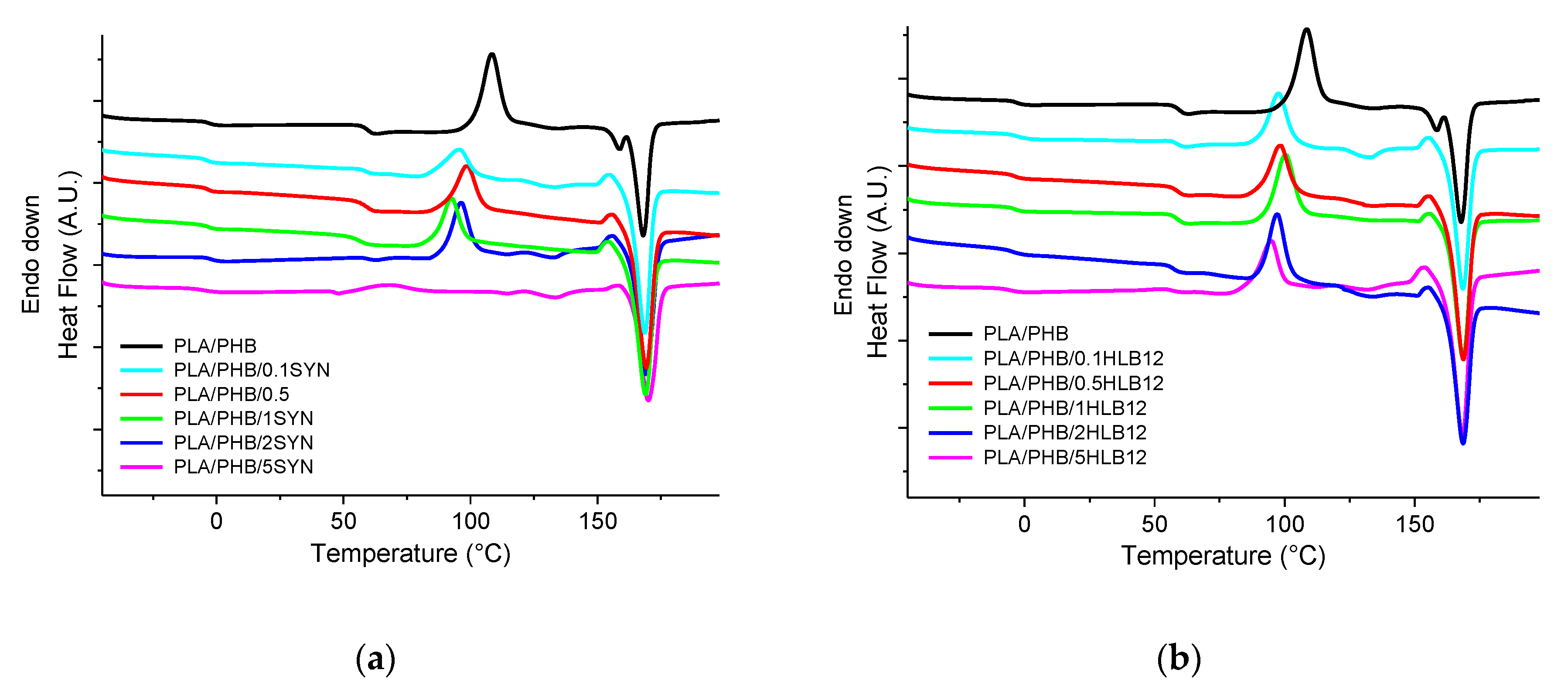
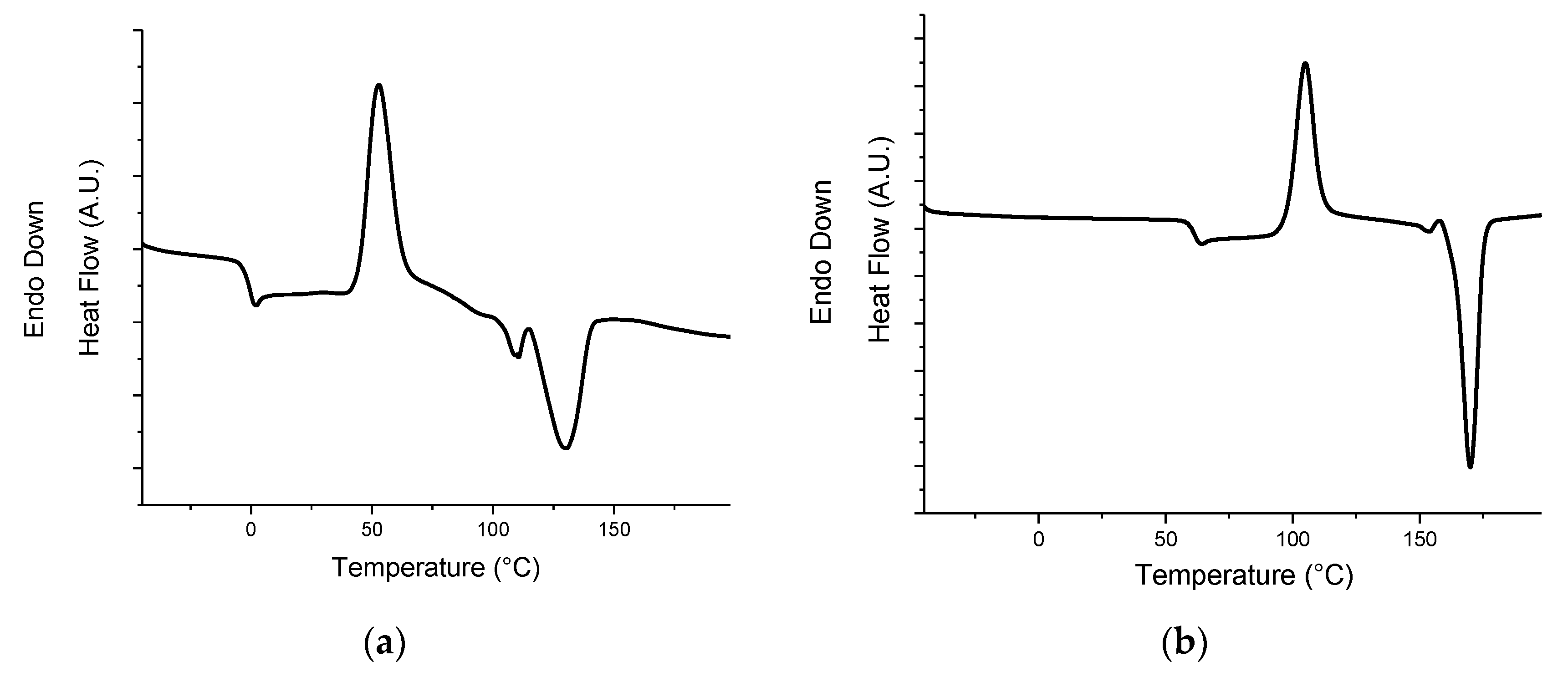
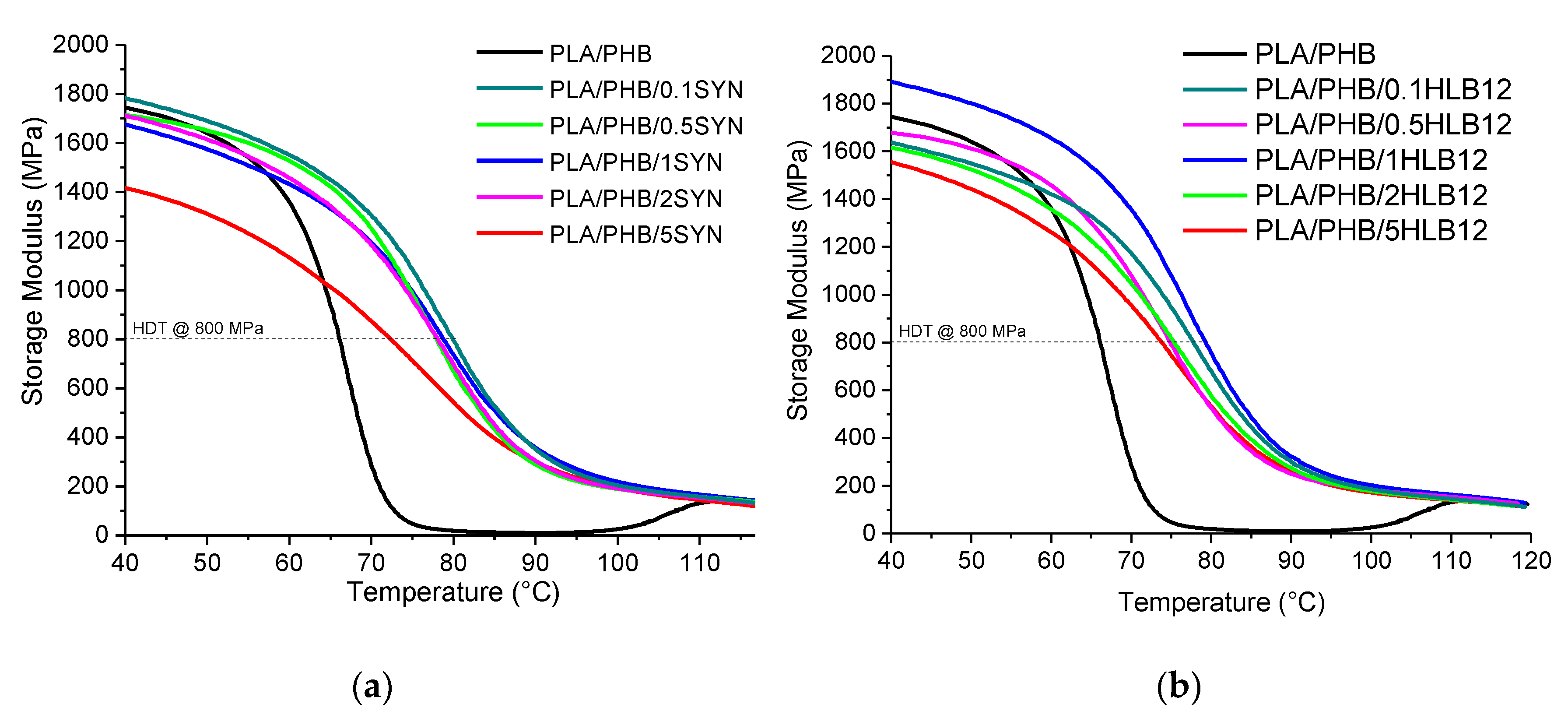
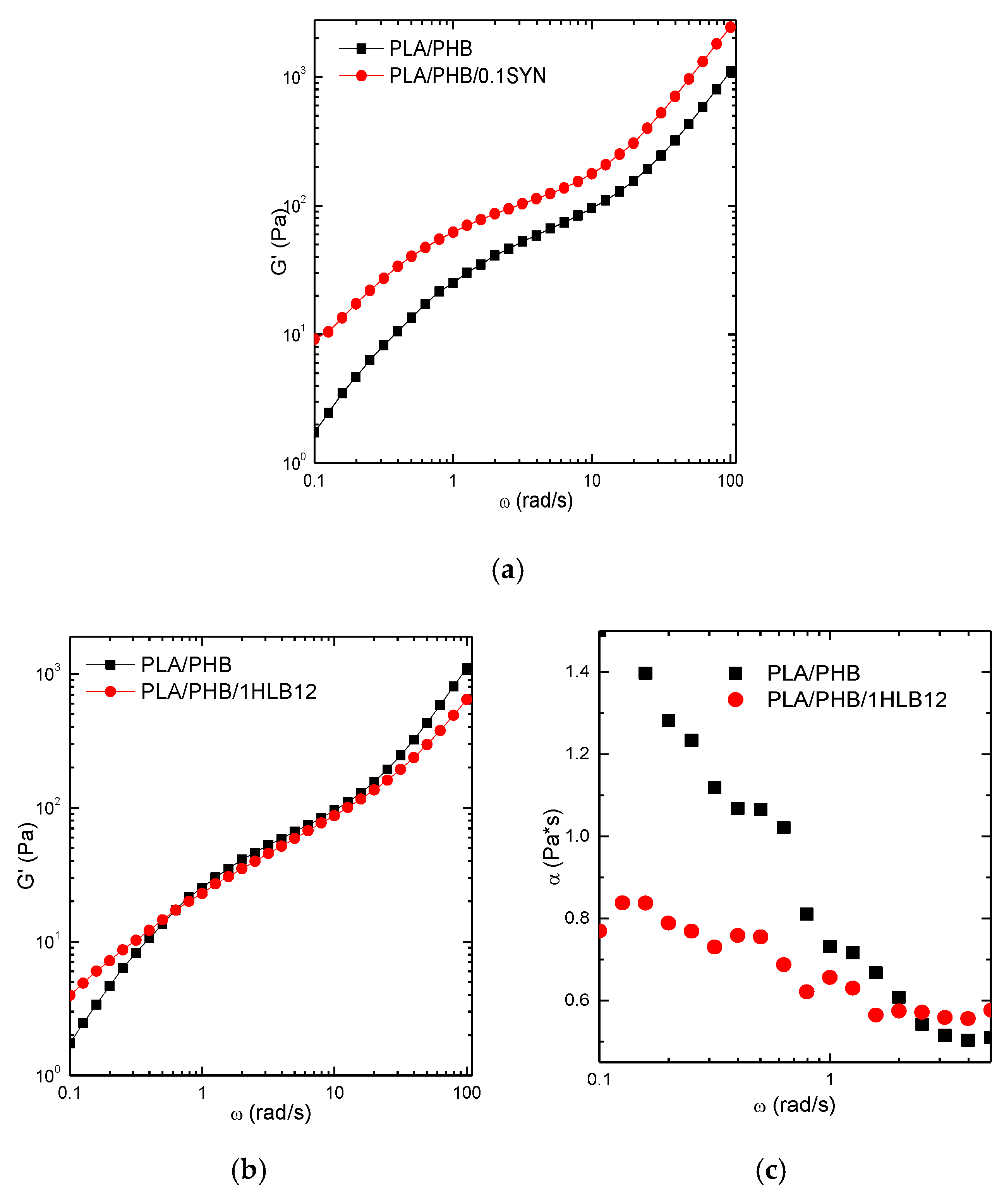
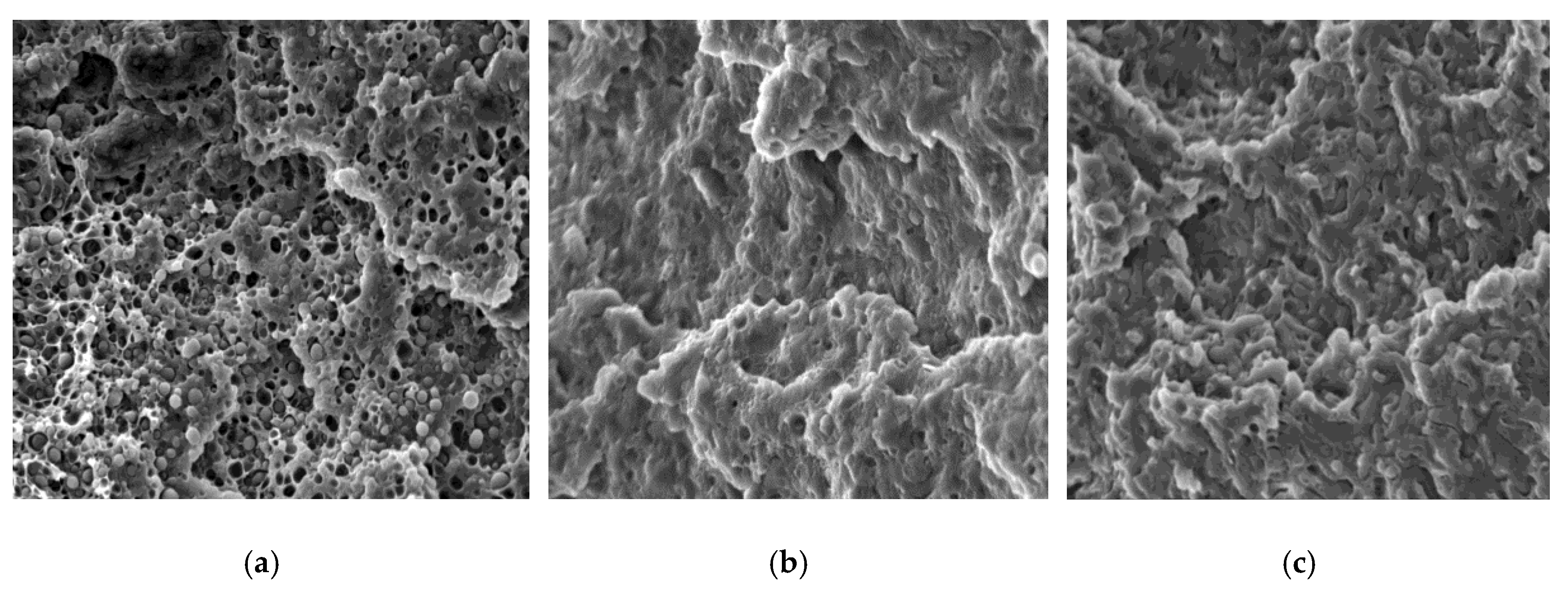
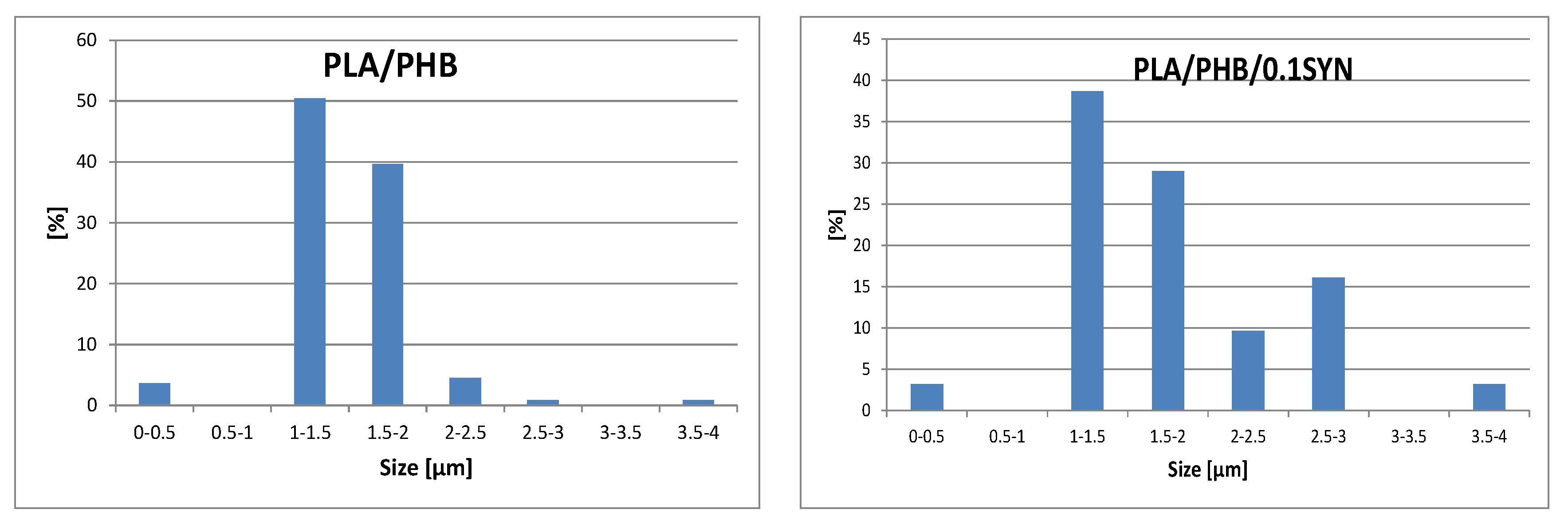
| Composition | Code |
|---|---|
| PLA: 70% and PHB: 30% | PLA/PHB |
| PLA: 70%; PHB: 30% and Synperonic: 0.1% | PLA/PHB/0.1SYN |
| PLA: 70%; PHB: 30% and Synperonic: 0.5% | PLA/PHB/0.5SYN |
| PLA: 70%; PHB: 30% and Synperonic: 1% | PLA/PHB/1SYN |
| PLA: 70%; PHB: 30% and Synperonic: 2% | PLA/PHB/2SYN |
| PLA: 70%; PHB: 30% and Synperonic: 5% | PLA/PHB/5SYN |
| PLA: 70%; PHB: 30% and HLB12: 0.1% | PLA/PHB/0.1HLB12 |
| PLA: 70%; PHB: 30% and HLB12: 0.5% | PLA/PHB/0.5HLB12 |
| PLA: 70%; PHB: 30% and HLB12: 1% | PLA/PHB/1HLB12 |
| PLA: 70%; PHB: 30% and HLB12: 2% | PLA/PHB/2HLB12 |
| PLA: 70%; PHB: 30% and HLB12: 5% | PLA/PHB/5HLB12 |
| Property | PLA/PHB | 0.1SYN | 0.5SYN | 1SYN | 2SYN | 5SYN |
|---|---|---|---|---|---|---|
| ΔHm [J/g] | 28 | 49 | 49 | 49 | 50 | 44 |
| ΔHcc [J/g] | 31 | 15 | 17 | 23 | 22 | 0 |
| χ [%] | 0 | 36 | 34 | 28 | 30 | 44 |
| Property | PLA/PHB | 0.1HLB12 | 0.5HLB12 | 1HLB12 | 2HLB12 | 5HLB12 |
|---|---|---|---|---|---|---|
| ΔHm [J/g] | 28 | 48 | 48 | 46 | 50 | 56 |
| ΔHcc [J/g] | 31 | 23 | 22 | 28 | 25 | 19 |
| χ [%] | 0 | 27 | 29 | 19 | 27 | 40 |
| Sample | PLA/PHB | 0.1SYN | 0.5SYN | 1SYN | 2SYN | 5SYN |
| Tandelta | 74 | 86 | 85 | 85 | 84 | 84 |
| HDT | 66 | 80 | 78 | 79 | 78 | 72 |
| Mod at 40 °C | 1752 | 1800 | 1652 | 1637 | 1678 | 1375 |
| Mod at 70 °C | 266 | 1327 | 1126 | 1186 | 1215 | 854 |
| Mod at 80 °C | 21 | 806 | 647 | 745 | 643 | 545 |
| Sample | PLA/PHB | 0.1HLB12 | 0.5HLB12 | 1HLB12 | 2HLB12 | 5HLB12 |
| Tandelta | 74 | 84 | 82 | 85 | 83 | 83 |
| HDT | 66 | 78 | 75 | 80 | 75 | 74 |
| Mod at 40 °C | 1752 | 1604 | 1651 | 1871 | 1638 | 1560 |
| Mod at 80 °C | 266 | 1143 | 1083 | 1351 | 1059 | 967 |
| Mod at 80 °C | 21 | 651 | 534 | 766 | 586 | 546 |
© 2019 by the authors. Licensee MDPI, Basel, Switzerland. This article is an open access article distributed under the terms and conditions of the Creative Commons Attribution (CC BY) license (http://creativecommons.org/licenses/by/4.0/).
Share and Cite
D’Anna, A.; Arrigo, R.; Frache, A. PLA/PHB Blends: Biocompatibilizer Effects. Polymers 2019, 11, 1416. https://doi.org/10.3390/polym11091416
D’Anna A, Arrigo R, Frache A. PLA/PHB Blends: Biocompatibilizer Effects. Polymers. 2019; 11(9):1416. https://doi.org/10.3390/polym11091416
Chicago/Turabian StyleD’Anna, Alessandra, Rossella Arrigo, and Alberto Frache. 2019. "PLA/PHB Blends: Biocompatibilizer Effects" Polymers 11, no. 9: 1416. https://doi.org/10.3390/polym11091416
APA StyleD’Anna, A., Arrigo, R., & Frache, A. (2019). PLA/PHB Blends: Biocompatibilizer Effects. Polymers, 11(9), 1416. https://doi.org/10.3390/polym11091416







